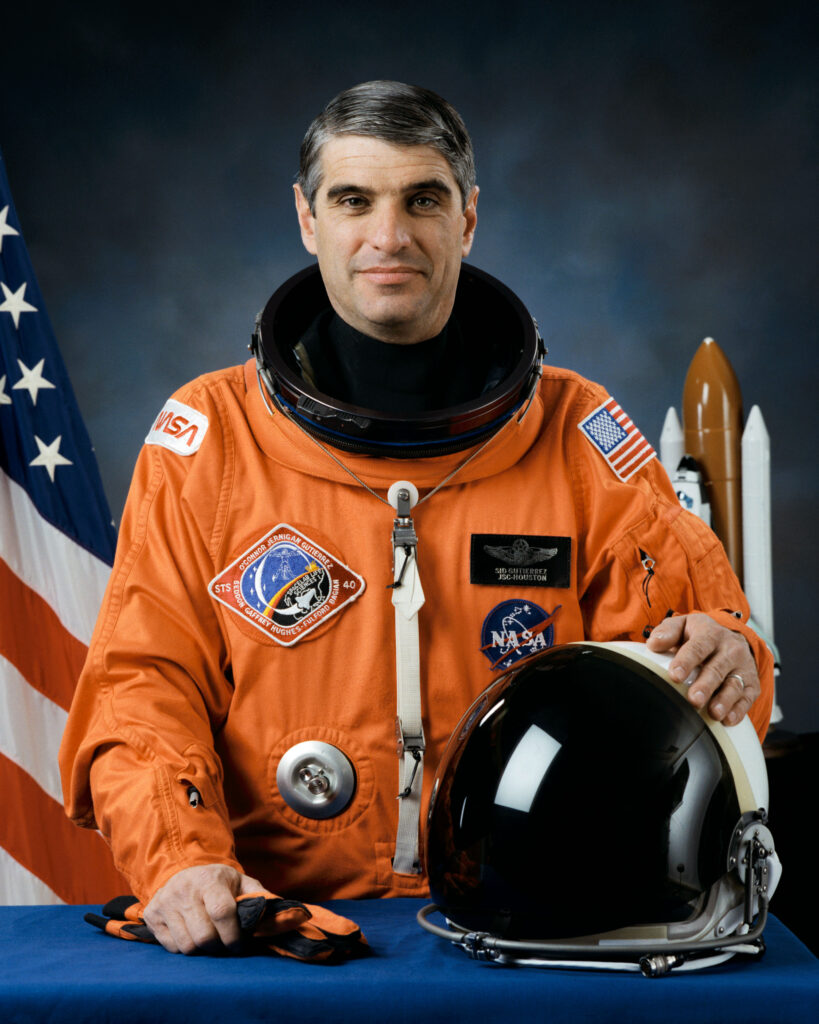Sidney “Sid” Gutierrez was born June 27, 1951, in Albuquerque, New Mexico. He graduated from Valley High School there in 1969, received a Bachelor of Science degree in Aeronautical Engineering from the U.S. Air Force Academy in 1973, and a Master of Arts degree in Management from Webster College in 1977.
After graduation from the Air Force Academy Gutierrez completed undergraduate pilot training at Laughlin Air Force Base (AFB) in Del Rio, Texas then was a T-38 instructor pilot there from 1975 through 1977. In 1978, Gutierrez was assigned to the Seventh Tactical Fighter Squadron at Holloman AFB in Alamogordo, New Mexico, where he flew the F-15 Eagle. He attended the USAF Test Pilot School at Edwards AFB in California in 1981 and was assigned to the F-16 Falcon Combined Test Force after graduation. While at Edwards, Gutierrez served as primary test pilot for airframe and propulsion testing on the F-16 aircraft. Test projects included the F-100 Digital Electronic Engine Control, F-16C & D Model Structural and Performance Testing, F-16 Maximum Performance Braking Tests, and F-16 Mobile Arrestment Qualification. He has logged over 4,500 hours flying time in approximately 30 different types of airplanes, sailplanes, balloons, and rockets.
Selected by NASA in May 1984, Sid Gutierrez became an astronaut in June 1985. In his first technical assignment, he served as commander for the Shuttle Avionics Integration Laboratory (SAIL), flying simulated missions to verify Shuttle flight software. Following the Shuttle Challenger tragedy in January 1986 he was an action officer for the Associate Administrator for Space Flight at NASA Headquarters. His duties included coordinating requests from the Presidential Commission and the U.S. Congress during the investigation. In 1986 and 1987, he participated in the recertification of the Space Shuttle Main Engines, Main Propulsion System, and External Tank. In 1988, he became the Astronaut Office lead for Shuttle software development, verification, and future requirements definition. In 1989 he helped support the launches of STS-28, 30, 32, 33, and 34 at the Kennedy Space Center (KSC) in Florida.
Colonel Gutierrez first entered space as Pilot on STS-40 Columbia launched from KSC on June 5, 1991. This was SLS-1, the first Spacelab Life Sciences mission, focused on how humans, animals, and cells respond to microgravity and re-adapt to Earth’s gravity on return. Other experiments investigated materials science, plant biology, and cosmic radiation. Following 146 orbits of the Earth in 218 hours, Columbia and her crew landed at Edwards AFB, California, on June 14, 1991.
Gutierrez was next spacecraft communicator (CapCom), the voice link between the flight crew and mission control, for STS- 42, 45, 46, 49, and 52. In 1992 he became the Astronaut Office Branch Chief for Operations Development, overseeing ascent, entry, abort, software, rendezvous, Shuttle systems, main engines, solid rocket boosters, external tank, and landing and rollout issues.
On April 9, 1994, Colonel Gutierrez returned to space as Commander of STS-59 Endeavour, Space Radar Laboratory (SRL-l). Part of “Mission to Planet Earth,” this was an eleven-day flight dedicated to the study of the Earth and the atmosphere around it. The two primary payloads were the Space-borne Imaging Radar-C/X-Band Synthetic Aperture Radar and Measurement of Air Pollution from Space. The crew completed over 400 precise maneuvers, a Shuttle record, and recorded enough data to fill 26,000 encyclopedias. Areas of investigation included ecology, oceanography, geology, and hydrology. The Endeavour completed 183 orbits of the Earth in 270 hours before landing at Edwards AFB, California, on April 20, 1994. In his two missions, Colonel Gutierrez logged over twenty days and eight hours in space.
In September 1994, Sid Gutierrez retired from the U.S. Air Force and from NASA. He returned to Albuquerque to work for Sandia National Laboratories. From September 1994 to March 1995, he served as Manager for their Strategic Initiatives Department then was Manager of the Airborne Sensors and Integration Department in the Exploratory Systems Development Center. He also served as Chairman of the Governor’s Technical Excellence Committee Spaceport Task Force.
Colonel Gutierrez next served on the Board of Directors of the Texas-New Mexico Power Company and Goodwill Industries of New Mexico and was a member of the New Mexico Space Center’s Governor’s Commission. Among his many honors are the NASA Outstanding Leadership Medal, NASA’s Exceptional Achievement Medal, two NASA Space Flight Medals, the 1990 Congressional Hispanic Caucus Award, the Aviation Week and Space Technology Aerospace Laureate in Space and Missiles for 1991; Aviation Week and Space Technology’s Citation for Aerospace Laureate in Space and Missiles for 1994, Distinguished Graduate of the USAF Academy; the Defense Superior Service Medal, the Air Force Meritorious Service Medal, Air Force Commendation Medal with 1 Oak Leaf Cluster, the National Defense Service Medal, and as an Air Training Command Master Instructor.

